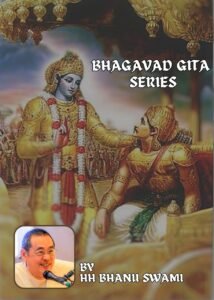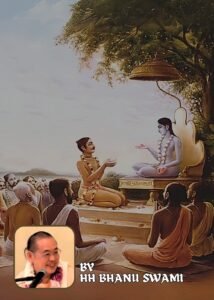Srimad Bhagavatam – 11.10.1 | HH Bhanu Swami Maharaj | ISKCON Chennai | March 19, 2021 |
Om Namo Bhagavate Vāsudevāya
Om Namo Bhagavate Vāsudevāya
Om Namo Bhagavate Vāsudevāya
nama om vishnu-padaya krishna-preshthaya bhu-tale
srimate bhaktivedanta-svamin iti namine
namas te sarasvate deve gaura-vani-pracharine
nirvishesha-shunyavadi-pashchatya-desha-tarine
jaya sri-krishna-chaitanya
prabhu nityananda
sri-adwaita gadadhara
shrivasadi-gaura-bhakta-vrinda
Hare Krishna Hare Krishna Krishna Krishna Hare Hare
Hare Rama Hare Rama Rama Rama Hare Hare
Reading from Srimad Bhagavatam Canto 11 Chapter 10 Verse 1.
ŚB 11.10.1
श्रीभगवानुवाच
मयोदितेष्ववहित: स्वधर्मेषु मदाश्रय: ।
वर्णाश्रमकुलाचारमकामात्मा समाचरेत् ॥ १ ॥
śrī-bhagavān uvāca
mayoditeṣv avahitaḥ
sva-dharmeṣu mad-āśrayaḥ
varṇāśrama-kulācāram
akāmātmā samācaret
Synonyms
śrī-bhagavān uvāca — the Supreme Personality of Godhead said; mayā — by Me; uditeṣu — spoken; avahitaḥ — with great care; sva-dharmeṣu — in the duties of devotional service to the Lord; mat-āśrayaḥ — one who accepts Me as shelter; varṇa-āśrama — the Vedic system of social and occupational divisions; kula — of the society; ācāram — conduct; akāma — devoid of material desires; ātmā — such a person; samācaret — should practice.
Translation
The Supreme Personality of Godhead said: Taking full shelter in Me, with the mind carefully fixed in the devotional service of the Lord as spoken by Me, one should live without personal desire and practice the social and occupational system called varṇāśrama.
Purport
In the previous chapters Lord Kṛṣṇa described through the story of an avadhūta brāhmaṇa the qualities and character of a saintly person. Now the Lord describes the practical means for achieving such a saintly position. In the Pañcarātra and other scriptures the Personality of Godhead gives instructions for executing devotional service. Similarly, in Bhagavad-gītā (4.13) the Lord says, cātur-varṇyaṁ mayā sṛṣṭaṁ guṇa-karma-vibhāgaśaḥ: “I have personally created the varṇāśrama system.” There are innumerable rules and regulations in the varṇāśrama system, and the devotee should execute those which do not contradict the process of devotional service. The term varṇa indicates different classes of human beings, some in the mode of ignorance, some in the mode of passion and some in the mode of goodness. Devotional service to the Lord is executed on the liberated platform, and therefore some injunctions for those persons in passion and ignorance may be contradictory to the regulative principles for those on the liberated platform. Therefore, under the guidance of a bona fide spiritual master who is nondifferent from the Lord, one should execute the basic principles of varṇāśrama in a way favorable for advancement in Kṛṣṇa consciousness.
HH Bhanu Swami Maharaj:
So, the whole previous chapter was talking about renunciation. And here we’re starting to talk a little bit differently about doing one’s occupational duties within the Varanashrama system. However, this Varanashrama system is described here as one, it has a Supreme Lord as the object or the goal. It says ‘mad-āśrayaḥ’, taking shelter of me. And then it says,’ akāmātmā’, one should perform those duties without material desire.
So, we’ll often see that the Bhagavatam rejects the Varanashrama system. And classifies it as very material. And similarly, we see Lord Caitanya also was not much interested in it. When he met the Madhvas in Udupi then the Madhvas said that the whole goal is to follow that Varanashrama system and then Lord Caitanya did not accept that answer. However, we should also understand that his rejection of the Varanashrama system does not mean that it is completely without value.
So even we can say doing activities with material desire in the Varanashrama system, it is somewhat acceptable. And therefore, we have the whole karma kanda section of the Vedas dedicated to sakama karma. Yet we also understand that, that is a lower process. And when one comes to the higher process of Jnana, one starts to reject that system. So, definitely the sakama portion of the Varanashrama system, the devotees reject that.
But they accept the nishkama or akama portion. So, they do the activities without aspiring for artha and kama. And they may avoid also those activities which are directly involving material desires. So, in other words they modify that system and its rules by their goal and by omitting some of the particular rules. So that is the higher type of Varanashrama. Still that is not really devotional. Within the Varanashrama system even the sakama portion, there is worship of the Supreme Lord. And it is said that without that worship of the Supreme Lord, you cannot even get your material desires fulfilled. However, it’s we can say a minor portion of their rules. So, if we come to nishkama, we get rid of the desires, but still the worship of the Supreme Lord is a minor portion.
So, the next step is to make that whole system more prominently Vaishnava. So that step we see here in which you take shelter of the Supreme Lord and offer all your activities to the Lord, that is the next step. So, in this way the bhakti portion becomes more prominent. However, we still make a distinction between nishkama karma yoga offered to the Lord and bhakti. When we are doing these activities of Varanashrama and offering to the Lord, fine it’s connected to the Lord, but bhakti activities are constitutionally related to the Lord. So kirtan means to sing the name of the Lord. So, if we make that our major activity then we are constantly engaged in worshiping the Lord automatically. So, we don’t have to modify that activity and say well let’s make it better by offering it to the Lord, its already offered to the Lord. Kirtan means to glorify the Lord so we are obviously trying to please the Lord.
However, in that bhakti again, we can have various forms. So we can say a step above nishkama karma yoga offered to the Lord is bhakti mixed with the karma. So we can do the activities of bhakti as our major thing, plus we can also do the Varanashramic activities. So nothing wrong with that if those activities are not contrary to bhakti and we don’t have those goals of artha and kama. So we can call that pure bhakti even if we are doing those rules of Varanashrama. And we see that was how many of the devotees acted in ancient times including the Caitanya Mahaprabhu and his followers. So they generally acted within the Varanashrama system.
And there are some also exceptional cases. So, Lord Caitanya, he actually touched the body of Haridas Thakur and he buried him with his own hands etc. which was actually not rather permitted by the Varanashrama system. But he took sannyasa and then he followed the rules of conduct of a sannyasi in general. And his followers who were Grahasthas then they followed the rules of Grahasta life. And they followed their particular varna, many were brahmanas, some were vaisyas, some were kshatriyas, some were sudras. So that is one way in which one can conduct oneself. There is another level in which that devotee does not do anything in the Varanashrama system and just does bhakti. So, this we can say is a very renounced person. So they don’t even belong to the sannyasa ashram. And they just do devotional service. So the last two types, those who are in the Varanashrama system practicing pure bhakti and those who are renounced, more or less we can say is similar because they are both in pure bhakti.
One can also have a case of a person who doesn’t do anything in the Varanashrama system, does bhakti, but he also mixes it with material enjoyment. So that is labelled rajo guna bhakti in the Bhagavatam. And if you mix it with liberation a little bit, Jnana misra bhakti so to speak, that is called sattva guna bhakti. So, the important point here is that when we do that bhakti, we may or may not follow all the rules of Varanashrama, but we should not mix in desires for material enjoyment or desires for liberation. Nor is the desire to get a spiritual body and go to the spiritual world. The desire is only to serve Krishna to please him. So that is pure bhakti. And that’s the ultimate recommendation of the Bhagavatam and other scriptures. It is with that process that we get that goal, Prema.
And to make that very clear, at the very beginning of the Nectar of Devotion, Rupa Gosvami gives a definition of bhakti. So, he gives a definition of Uttama bhakti. So ‘Uttama’ means of course best or excellent. It also means beyond ignorance, beyond tama. So, in other words it is pure bhakti not mixed bhakti. So, there he says it is ‘anya abhilashita sunya’, it is unmixed with other desires. It is not without desire. But because we have to have a desire to serve Krishna. But other desires than the desire to serve Krishna, those are rejected. However, it also says that it is ‘Jnana karma adi anavrtam’, it is not obstructed by Jnana, karma and other processes. But it does not say, you cannot do those activities. But they should not obstruct bhakti. So they become obstructive, if they carry with them other desires. And if they have no other desires with them then also it is still pure bhakti. So that is the general statement at the beginning of the Nectar of Devotion.
So the devotee practices, that is sadhana. So he practices pure bhakti in sadhana and then he progresses to bhava. And then he gets to Prema. So it is that pure bhakti as a sadhana which leads to Prema. But if we do some other bhakti which is not Uttama bhakti then we don’t get to that bhava and Prema. Since the goal of the Jiva is Prema, Rupa Gosvami therefore recommends that we start with this Uttama bhakti. People may start with a mixed bhakti with desires for getting rid of their distress or getting some material benefits. So, this is also accepted by the Lord. Krishna in Bhagavad Gita says four types of people come to me- those who are in distress, those who want material assets. And Krishna accepts those people as devotees. But they are not the highest devotees. So the hope is that those people practicing a mixed bhakti will eventually develop pure bhakti. The only way they can get from that mixed bhakti to pure bhakti is by getting the association of devotees who are practicing pure bhakti. So therefore, ultimately the process recommended in the scriptures is pure bhakti.
So, as I said, in general the followers of Lord Caitanya followed this process where they performed Varanashramic duties along with their practice of pure bhakti. But they didn’t have material motives in practicing those particular actions. The question will come, why don’t we just do bhakti and nothing else. Well the problem is, we have a material body. And if we have a material body, you have to eat, you have to walk around, you have to breathe, you have to drink water, you have to do so many things, so you can’t just do bhakti. So these activities of the body can be a big disturbance. So we have to do the activities of the body in such a way that they create minimal disturbance. So, the rules of Varanashrama help in that regard. So the Varanashrama system provides rules which are favourable for spiritual development.
So, in other words, they help you control your senses and control your mind. They help with the purity of body and purity of mind. They help create an occupation which is not disturbing. So, in this way the rules of the Varanashrama system act as an assistant to bhakti. In that they provide a favourable body and a favourable setting in society for developing the bhakti. So, we cannot avoid supporting our material body. So we can manufacture our own rules that may or may not work or we can follow those rules of the Varanashrama system which are scriptural. Still our Acharayas warn, you should not be too attached to those rules also. We may become attached to the rules because of the rules not because of their goal. So, if they become an obstacle to bhakti, then we have to be detached from them. So therefore, the rules are practiced but with some discretion and without attachment. So this is how the devotees conduct themselves.
Hare Krsna!
Q&A
1) We find that when Mahaprabhu was in conversation with Ramananda Rai, he rejected Varnashram. But in the role of sannyas, Mahaprabhu strictly followed sannyas dharma. He even banished Chotta Haridas. So, how to understand this?
So, He didn’t reject the Varnashrama system, this is not the main goal of the human life that’s all. The main goal is surrender to Krishna.
Devotee: But if Varnashrama is not imposed some neophyte devotees may just leave like they may not follow rules, because Varnashrama has lot of do’s and don’ts initially devotees have to follow rules and don’ts initially they think “oh i don’t want to follow Varnashrama let me perform pure bhakti” and they may land up in disaster.
HH Bhanu Swami Maharaj: For that reason, i mentioned the third type of devotee who doesn’t follow generally that is a person who is very qualified and is very renowned so he gives up following those rules.
But then we come to the whole problem of people who were not born in India with no Varnashrama rules to begin with so what do they do? So those devotees also to some degree they practice those favourable rules which they can for their spiritual development.
2) What about higher planetary system, they also have this Varnashrama? Brahmana, Vaishya, Kshatriya?
So, they are predominantly sattvika and they don’t have like sudras and varnas up there but they also have rules.
Devotee: There are some rakshasas and demons there are some rakshasas and demons they must be in tamo guna
HH Bhanu Swami Maharaj: Well, we have rakshasas generally there in the Bhuvarloka below Svarga.
3) Is it possible to attain pure bhakti within this life when we are in mix of sinful people of Kaliyuga and limitations of Jiva living in Kali-yuga?
So, pure bhakti is a sadhana, it’s also prema, it’s also sadhana. So therefore when we are doing our sadhana we have to practice pure bhakti and of course not only now but previously also those who were devotees were living in a society of people who were not all devotees they may be smartas or demons or materialists or whatever. So the devotees have to protect themselves by association of other devotees.
4) Hare Krishna Maharaj. Even though devotees practice bhakti by chanting and taking prasad but while preparing the bhoga they may think what they like and they prepare and offer to krishna how we understand that?
Well to some degree that is allowed. In other words, we don’t offer the deity things which we think are very very bad let’s offer all the bad things to the Lord and we’ll take the good things. We shouldn’t do that, but when we are offering we are not thinking, ‘I offer because I am going to enjoy it.’
5) Maharaj, in case of difficulties if a devotee prays to the Supreme Lord then that will not be called a pure bhakti?
So in the definition is “anyābhilāṣitā-śūnyaṁ” so in general one should not have other desires but it is allowed exceptionally but not constantly.
6) Maharaj, for a sadhaka, who is neophyte how to identify that the person is not doing mixed bhakti especially in contest of taking siksha from that person?
I suppose the only way you can tell is, if he tells you to worship bhakti for getting material desires fulfilled or something then it will be mixed bhakti.
7) Maharaj is Yamadudas are pious souls?
Well they are followers of Yamaraja who was a great Mahabhagavata devotee.
Devotees: Grantharaj Srimad Bhagavatham ki jai!!! HH Bhanu Swami Maharaj ki jai!!!


